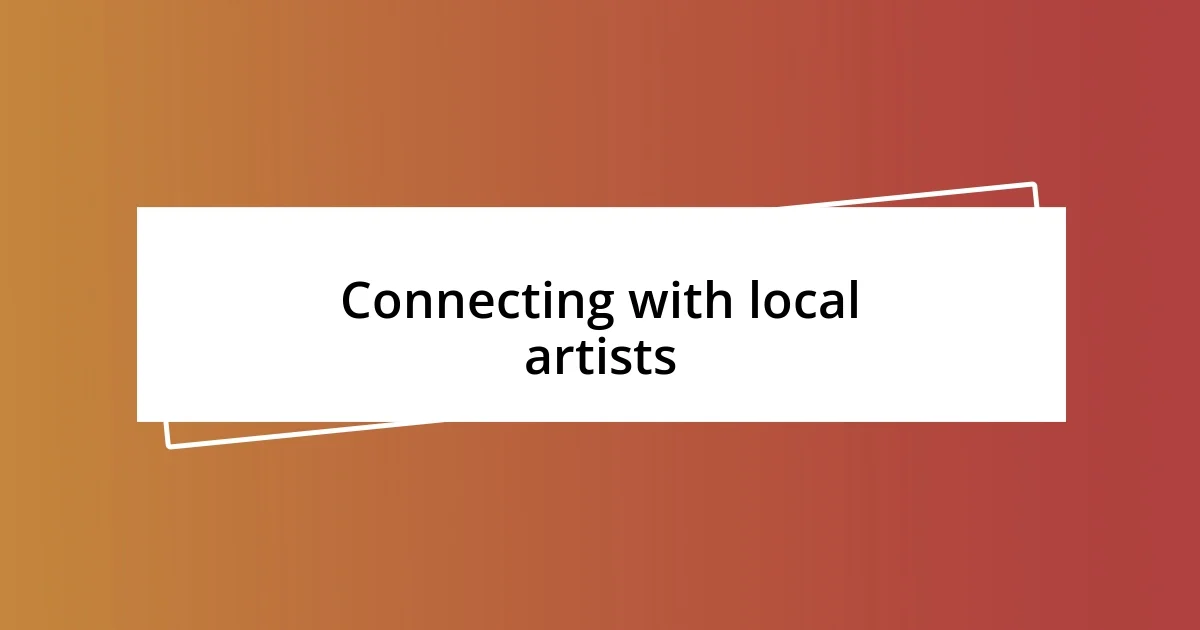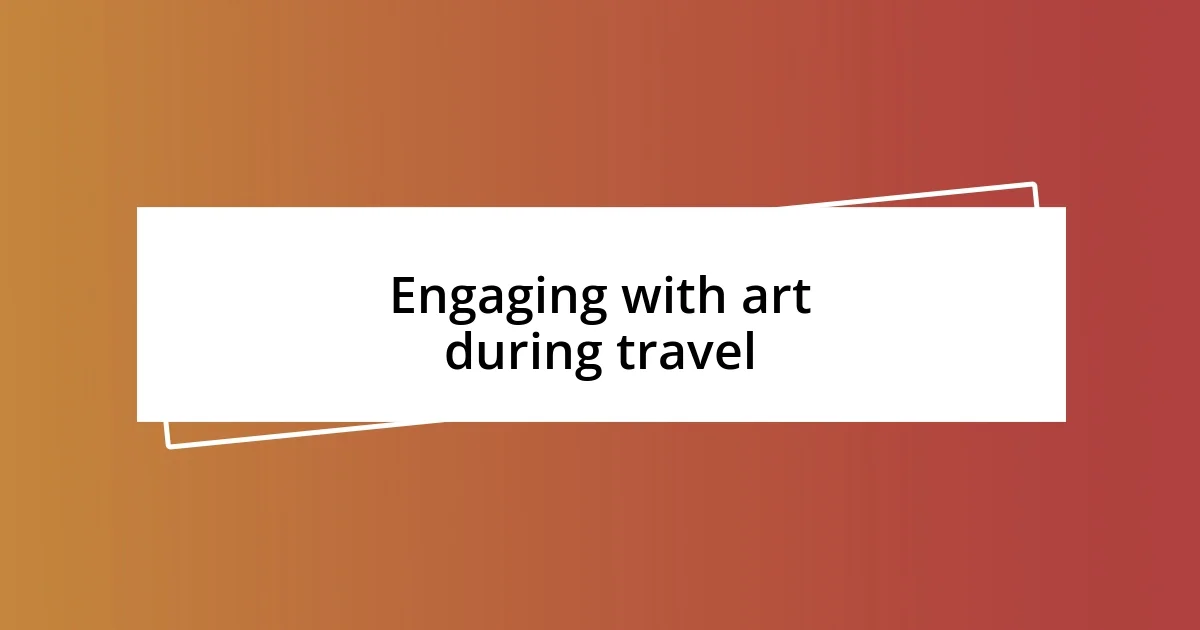Key takeaways:
- Art serves as a universal language, enhancing travel experiences by providing deeper cultural insights and emotional connections to places.
- Engaging with local artists transforms sightseeing into meaningful exchanges, revealing community values, traditions, and preserving cultural heritage.
- Documenting artistic experiences through photography and journaling enriches personal reflections and keeps alive the stories of places visited.

Understanding the role of art
Art acts as a universal language, transcending geographical borders and cultural differences. I vividly recall standing in front of a vibrant mural in a bustling street market, feeling an instant connection to the local community. The colors and shapes made me ponder—how often do we encounter a piece of art that speaks to our shared humanity?
When I think about the role of art in my travels, I realize it often provides a lens through which to understand a place more deeply. On a rainy afternoon in Paris, I found myself in the Musée d’Orsay, surrounded by Impressionist masterpieces. Each brushstroke seemed to tell a story, evoking emotions that resonated with my own experiences. It made me consider—how can art evoke feelings that words alone sometimes can’t capture?
In every corner of the world, art has helped me engage with unfamiliar cultures and histories. I remember visiting a traditional market in Morocco, where the intricate tile work captivated me. As I traced the patterns with my fingertips, I felt the rich heritage and skilled craftsmanship behind each design. It struck me that art is not just about aesthetics; it’s a powerful gateway to understanding different ways of life.

Finding art in travel
Finding art in travel is like uncovering hidden treasures that enrich your journey. I remember wandering through the streets of Florence, where every façade seemed to tell a story. I stumbled upon a tiny gallery tucked away from the bustling tourists, and there, a local artist passionately painted scenes from everyday life. Watching her work was a reminder that art is often rooted in the most mundane moments, elevating them into something beautiful.
- Art transforms mundane spaces into places of reflection.
- Unique regional styles reveal cultural identities.
- Local artists provide insights into community values and traditions.
- Unplanned encounters with art can redefine your travel experience.
On my travels through Japan, I found art in the serenity of a Zen garden. The carefully raked gravel and perfectly placed stones whispered a harmony I never knew I needed. While sitting there, I felt a sense of calm wash over me—a moment of connection not just to the art, but to the philosophy that birthed it. It made me realize that art isn’t just something to see; it’s something to experience and feel deeply within oneself.

Art as a cultural lens
Art has always been a mirror reflecting the values and narratives of a culture. I recall standing in awe at a traditional Balinese dance performance during my visit to Indonesia. The intricate costumes and expressive movements told stories of gods and legends, immersing me in the spirit of the local beliefs. It sparked a question in my mind: how does art encapsulate cultural identity in ways that words sometimes fail to convey?
In another instance, while exploring the vibrant streets of Mexico City, I stumbled upon an open-air gallery showcasing the works of local muralists. Each mural was a bold statement about social justice, history, and the intertwining of past and present. I took a moment to chat with one of the artists, and his passion was palpable. He explained that every brushstroke connected to the community and its stories. This interaction reaffirmed my belief that art not only reflects culture but also motivates dialogue and inspires change.
I often find myself pondering how art serves as an emotional archive of humanity. During my time in Greece, I visited an ancient amphitheater where the acoustics allowed me to hear my own whispered thoughts echo back at me. Sitting there, surrounded by monumental ruins, I felt the weight of history and the stories left behind. It clarified my understanding: through these artistic expressions, cultures preserve their essence, inviting us to share in their legacy.
| Art Experience | Cultural Insight |
|---|---|
| Balinese Dance Performance | Reflects local beliefs and folklore |
| Street Murals in Mexico City | Addresses social issues and community identity |
| Ancient Amphitheater in Greece | Preserves history and emotional resonances |

Connecting with local artists
One of my most memorable encounters occurred in a small coastal town in Portugal. While wandering through its narrow streets, I was drawn into a bustling workshop where a local ceramist was crafting intricate tiles by hand. I watched, mesmerized, as she explained the traditional techniques passed down through generations. Did you know that each tile tells a different story about the town’s heritage? That moment was magical; connecting with her not only enriched my travel experience but also deepened my understanding of the local culture.
During a visit to a vibrant art festival in New Orleans, I found myself sitting on a park bench beside an artist displaying his colorful canvases. As we struck up a conversation, he shared the struggles and triumphs behind his work, which depicted the city’s resilience. I could almost feel the heartbeat of the community in his words. How could I not be moved by such passion? Engaging with local artists like him transforms a mere sightseeing trip into an exploration of the human experience.
In the Maldives, I met a group of talented craftsmen who specialized in traditional boat-making. It wasn’t just a simple demonstration; watching them work felt like stepping into a living museum. Their hands moved with a rhythm rooted in age-old practices, and I couldn’t help but wonder how much history they were preserving with each crafted vessel. Isn’t it incredible how art and craftsmanship can bridge the past and present? That connection turned a day at the beach into a profound appreciation for the rich culture surrounding me.

Engaging with art during travel
Engaging with art during travel can profoundly transform our experiences. I remember wandering through the bustling markets of Marrakech, where the vibrant colors of woven rugs and painted ceramics caught my eye. Each stall felt like a mini-gallery, beckoning me to explore the skill and spirit embedded in local craftsmanship. How fascinating it is to realize that these pieces don’t just decorate homes; they encapsulate the stories and traditions of their makers!
On another occasion, while visiting a small art studio in Barcelona, I stumbled upon a painter who was capturing the essence of the city’s architecture. Watching her work was a revelation, as she shared how the interplay of light and shadow influenced her brushstrokes. Her enthusiasm was infectious, igniting my curiosity about how local scenery might inspire artists everywhere. Isn’t it amazing how a simple interaction can deepen our appreciation for a place?
The experience of engaging with art often leads us into unexpected conversations. I recall an evening spent at a street art festival in Berlin, where I found myself chatting with a graffiti artist who was painting a massive mural. He spoke passionately about the role of street art in challenging societal narratives. Listening to him made me reflect on how art can serve as a voice for the unheard. What an eye-opener it was to see creativity as a form of rebellion and dialogue, transcending cultural boundaries!

Documenting artistic experiences
Documenting my artistic experiences during travel has become a cherished practice. I remember capturing moments with my camera, each click freezing a vibrant scene into memory. For example, in a quaint Italian village, I stumbled upon an artist dedicating hours to painting a vivid landscape. I could hardly resist snapping a photo, feeling an overwhelming urge to share his passion with the world. Isn’t it incredible how a single image can tell a story that transcends borders?
Journaling also plays a vital role in this process. After visiting a breathtaking gallery in Paris, I found myself writing down my impressions and emotions. There’s something therapeutic about reflecting on the colors, textures, and sensations I encountered. I often wonder—how does writing about these experiences enhance my connection to them? The act of putting pen to paper allows me to internalize moments that might otherwise fade with time, making them feel even more valuable.
Sometimes, my documentation goes beyond just photos and words. I’ve taken to collecting small art pieces—like hand-painted coasters from a local artisan in Mexico. Each piece I bring home holds its own narrative, a tactile reminder of that specific moment and place. How thrilling it is to realize I’m not just collecting souvenirs, but rather keeping a piece of someone else’s story alive in my home! These artifacts serve as conversation starters, evoking memories that transport me back to those enchanting experiences.

Transforming travel through art
Art has a unique way of transforming our travel experiences, pushing us to look deeper than the surface of a destination. I remember standing in front of a striking mural in Buenos Aires, feeling a rush of emotions wash over me. The colors and imagery were so vivid that they seemed to tell the story of the city and its people. It made me wonder—how many stories are painted on the walls of cities, waiting for us to notice?
When I visited the majestic temples of Kyoto, I noticed how art and spirituality intertwined. Each intricate carving and delicate painting felt like a whisper from the past, inviting me to reflect on my own journey. That sense of connection was profound; it was as if I were part of a larger tapestry woven over centuries. Can art truly bridge the gap between our experiences and the stories of those who came before us? In my travels, I’ve discovered that it can.
Participating in local art workshops has also enriched my understanding of a place. I vividly recall learning traditional pottery techniques in Japan, my hands molding clay while an artisan patiently guided me. As I shaped my piece, I felt a sense of unity with the local culture, almost as if I were absorbing their history into my very being. How empowering it is to not just observe art but to create it alongside those who master it? That moment forged a connection that lingered long after I left, reminding me of the powerful role art plays in our travel narratives.














